
 |
|
|||||||
| Forum Rules | Firearms Safety | Firearms Photos | Links | Library | Lost Password | Email Changes |
| Register | FAQ | Calendar | Today's Posts | Search |
 |
|
|
Thread Tools | Search this Thread |
|
|
#1 |
|
Senior Member
Join Date: August 17, 2008
Location: Fort Riley, Kansas
Posts: 139
|
Richard conversion?, Transitional?, Richard mason open top?
Alright I'm trying to figure out the difference between the 1860 army Richard conversion, The transitional, the type II and the Richard mason 1871-72 open tops. I'm extremely confused trying to figure out which one is which and which one was produced the most? I want to buy the 1860 Richard-Mason army from cimarron in 45 colt with the 8 inch barrel but I cant tell which one it is. Is it the Richard conversion, the transitional, the type II or the Richard mason? They all look the same to me besides the sights and loading gates. Which one is which? Which one was produced the most and what makes them different from each other. I noticed that Uberti has them all categorized but then i also notice that some have the rear sights on the rear of the barrel or the hammer but on some original examples the rear sight is on the frame. I'm so confused...This would greatly help me make a decision in my purchase.
http://www.cimarron-firearms.com/pro...ason-army.html |
|
|
|
|
#2 |
|
Senior Member
Join Date: July 17, 2015
Location: South Central MO / Africa
Posts: 1,111
|
No help but I'm going to send you a link to gunbroker auction you might find interesting.
__________________
NRA Life Member |
|
|
|
|
#3 |
|
Senior Member
Join Date: September 8, 2007
Location: Mississippi
Posts: 16,188
|
The Thuer conversion was just a cylinder conversion, no ejector rod. The Richards had an ejector rod with a short housing and barrel mounted sight. The Type II transitional model had the short housing with the Richards Mason conversion ring with the rear sight. The Richards Mason has a longer ejector rod housing and conversion ring sight.
|
|
|
|
|
#4 |
|
Senior Member
Join Date: August 17, 2008
Location: Fort Riley, Kansas
Posts: 139
|
So would this be a Richards or a type II? The ones they display on the site look to have the same housing for the ejector rod and same sights. Which one is the one I'm showing in the link attached.
http://www.cimarron-firearms.com/186...in-barrel.html |
|
|
|
|
#5 |
|
Senior Member
Join Date: September 8, 2007
Location: Mississippi
Posts: 16,188
|
That's a Richards Mason with the long ejector rod housing. The 1872 open top has the ramrod hole filled and the rear sight is back on the barrel and the cylinder isn't rebated.
|
|
|
|
|
#6 |
|
Senior Member
Join Date: October 25, 2001
Location: Alabama
Posts: 18,535
|
Says it is a Richards Mason and looks like the one in Flayderman.
|
|
|
|
|
#7 |
|
Senior Member
Join Date: October 18, 2015
Posts: 103
|
I don't know, exactly, but I think you have the right idea. My next gun will be a 5 1/2" 1872 Open Top Navy, .38 Special. Because I was bequeathed a ton of .38 Special ammo, and I don't like to run it through a .357. Seems a shame to run all that .38 ammo through a plain-Jane, no personality, ordinary double action snubby. I like those little Navys, classy-looking.
|
|
|
|
|
#8 |
|
Senior Member
Join Date: August 7, 2000
Location: Floating down the James River in VA
Posts: 2,599
|
Cimarron offers three models with the 1860 army gripframe: a Richards ll using the original 1860 army barrel, a Richards Mason with the conversion ring and newly made S lug barrel, and a "late model" open top, which isn't really a conversion. All were made over roughly the same period, with a slightly earlier edge to the RM. Richards conversions for the army were the most common, with about 9k made compared to 2100 rm armies. 7k open top were made. Most common conversions we're 1862 police and pocket navy...24k
|
|
|
|
|
#9 | |
|
Senior Member
Join Date: September 8, 2007
Location: Mississippi
Posts: 16,188
|
Quote:
|
|
|
|
|
|
#10 |
|
Senior Member
Join Date: January 3, 2014
Location: Land of the Pilgrims
Posts: 2,033
|
Howdy
I agree, identifying the various Colt Conversion Models can be very confusing. The Thuer Conversion was a not very successful attempt to get around the Rollin White patent for bored through cylinders. There were number of different sized Thuer Conversions, but they all had chambers that were tapered from front to back, and used a cartridge that was tapered from front to back. The cartridges were loaded from the front of the cylinder. The tapered chambers was the way Colt got around the Rollin White patent because 'bored through' was interpreted to mean the diameter was bored straight through with no taper. The Thuer Conversion did not sell very well, only about 5000 were made in 1869 and 1870. The White patent expired in 1869 and Colt engineers were hard at work coming up with a design that would use conventional cartridges. Charles B. Richards was clever designer working for Colt and he came up with three patents from 1868 through 1871 for improvements to revolvers. Patent 117,461 awarded in July of 1871 was for the 'Richards Conversion'. The Richards Conversion was mostly done to the 44 Caliber 1860 Army Model, although a few 36 caliber Navy models were converted too. The frame of the revolver was cut back to receive a Breech Plate. The Breech Plate had a loading gate, not too different than the loading gate that would later appear on the Single Action Army. There was a raised rear sight cast onto the Breech Plate and the there was a spring loaded firing pin contained in the Breech Plate. The cylinder was cut back at the rear to remove the area where the nipples had been and a centerfire cartridge was designed to fit the bored through chambers. This was the .44 Colt cartridge, but the heeled bullet was actually about .451 in diameter, which was the rifling groove diameter of these '44' revolvers. That's a whole different story. Lastly, the loading lever under the barrel was removed and a complicated ejector mechanism was built that fit into the recess where the loading lever had been. Approximately 9000 Richards Conversions were built, both from modified original parts and new parts. This is an original Richards Conversion with a few original 44 Colt cartridges. As I said, identifying these models can be confusing, this one was mislabeled as a Richards-Mason Conversion when I bought it. 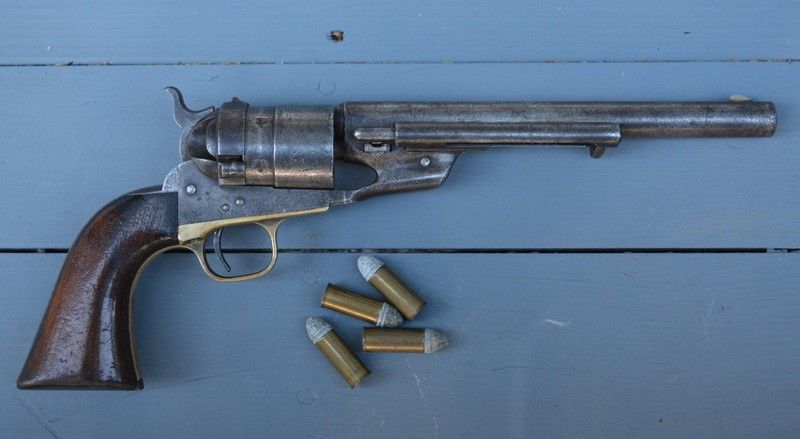 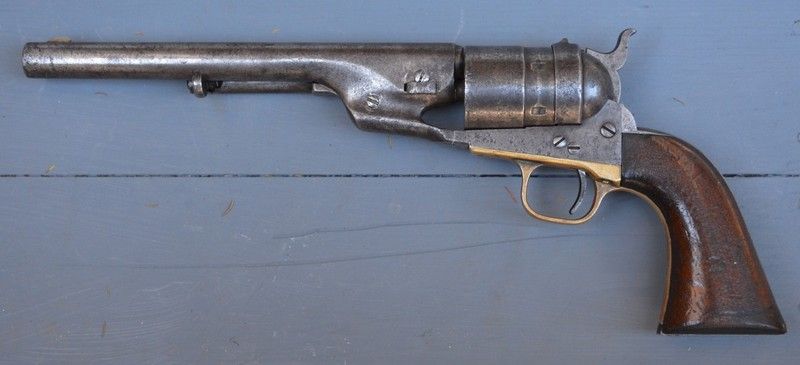 This is the cylinder. The area where the nipples were has been milled away, but the ratchet teeth remain. 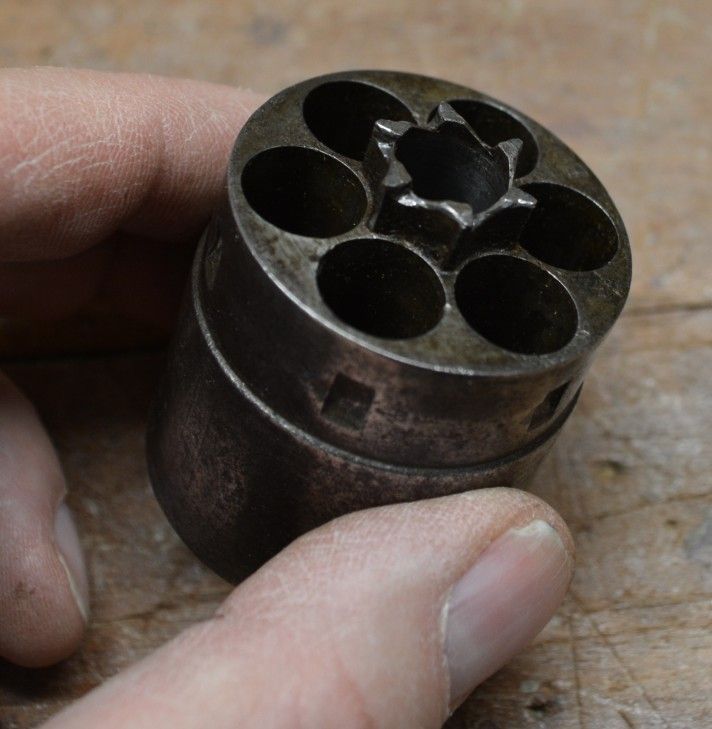 This view shows the loading gate open, revealing the ratchet teeth on the cylinder. Yes, there is some gridue on the loading gate, I had not cleaned the gun thoroughly before taking these photos.  This view shows the spring loaded firing pin in the breech plate and the rear sight cast onto the breech plate. You can also see how the hammer face was cut flat where it strikes the firing pin. 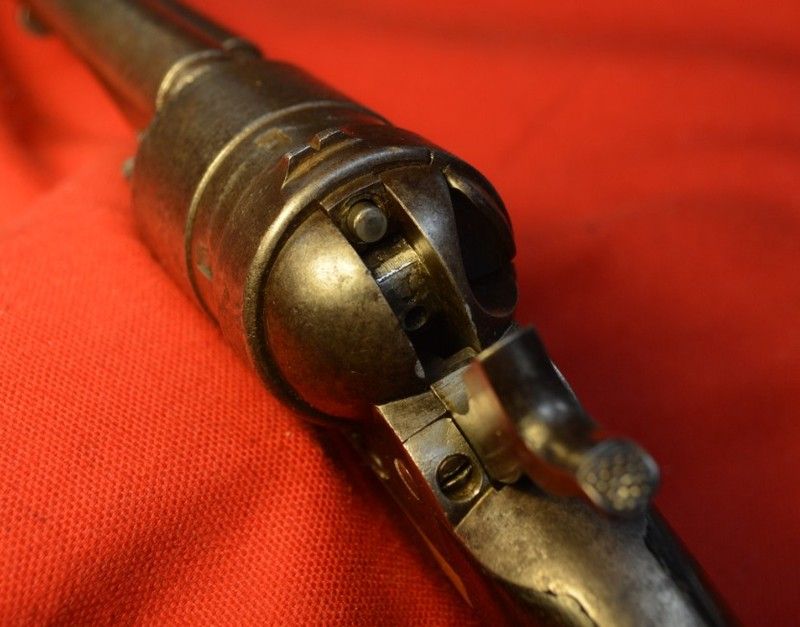 This view shows how the ejector rod mechanism was fitted into the hole where the loading lever had been. It is a complicated part, held in place by one screw. The screw holding this one in place is pretty buggered up, so I have not attempted removing the ejector mechanism for a separate photo. 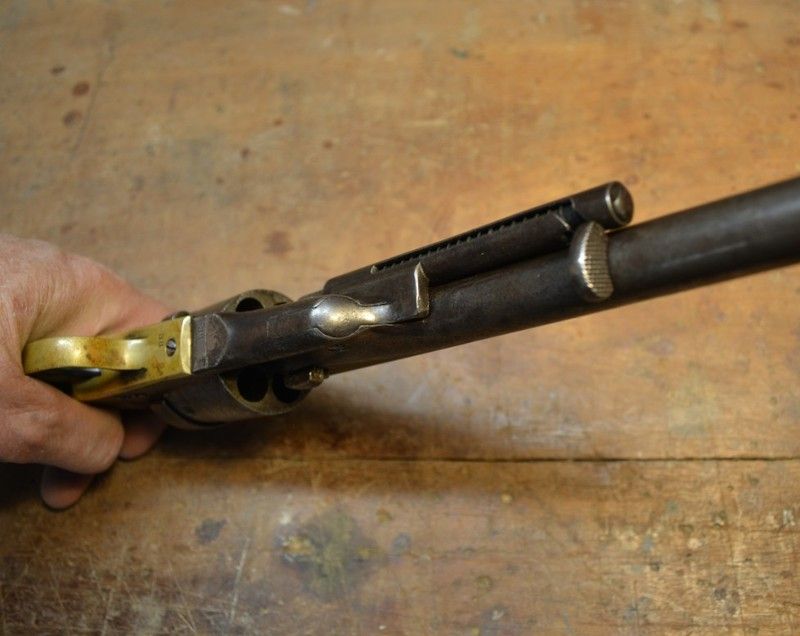 That's all the photos I have for you, to understand differences with the Richards-Mason conversion and the Open Top you will have to look at somebody else's photos. The Richards Conversion was a clever step forward in cartridge revolver design, but some of the parts were expensive to produce, particularly the extractor assembly. William Mason came up with a simpler design for the extractor. The barrels were all made new, there was no hole for a loading lever. Instead the extractor mechanism had a stud on the side that fitted into a recess on the side of the barrel lug and it was secured by a screw from the opposite side. A much simpler design. The frame mounted, spring loaded firing pin was done away with and a firing pin was mounted in the hammer face. The rear sight was removed from the breech plate and a notch was cut into the hammer much like a percussion Colt to serve as a rear sight. Richards-Mason conversions were made to the 1860 Army revolver, 1851 Navy, 1861 Navy, as well as some pocket models. Approximately 2,100 Army Richards-Mason Conversions were produced in 1877 and 1888. I don't have any production figures for the 1851 Navy Richards-Mason Conversions, but approximately 2,200 1861 Navy Richards-Mason conversions were made. Lastly there were the Open Tops. The Open Tops were not really conversions in that they were not conversions of existing percussion revolvers. They were all built from new parts. The identifying features of the Open Tops is the large caliber cylinders were not rebated because they were not made from cut down percussion cylinders. The firing pin was mounted on the hammer, and there was a small raised rear sight at the rear end of the barrel, just in front of the forcing cone. The Open Tops were primarily only produced from February of 1872 until June of 1873. Sorry, I don't currently have any production numbers on the Open Tops. So........Identification Key: Raised rear sight on breech plate, spring loaded firing pin, complicated ejector assembly - Richards Conversion. Firing pin on hammer, small notch on the hammer for a rear sight, simple ejector assembly mounted on the side of the barrel lug - Richards-Mason Conversion. Firing pin on hammer, rear sight on barrel - Open Top. |
|
|
|
|
#11 |
|
Senior Member
Join Date: August 7, 2000
Location: Floating down the James River in VA
Posts: 2,599
|
Hawg: pretty sure the Richards ll were sold to the army from 1873-1878...putting them after the RM conversions. Original Richards may have actually been slightly earlier per McDowell...possibly avoiding the Rollin White patent. In essence, aside from original Richards conversions with frame mounted fp, most other versions are concurrent with open tops, RM and even early SAA.
|
|
|
|
|
#12 |
|
Senior Member
Join Date: September 8, 2007
Location: Mississippi
Posts: 16,188
|
The Thuer was the workaround to the Rollin White patent. The Richards was developed in 1871 the Richards Mason was developed in 1872.
|
|
|
|
|
#13 | |
|
Senior Member
Join Date: January 3, 2014
Location: Land of the Pilgrims
Posts: 2,033
|
Quote:
|
|
|
|
|
|
#14 | |
|
Senior Member
Join Date: September 8, 2007
Location: Mississippi
Posts: 16,188
|
Quote:
|
|
|
|
|
|
#15 |
|
Senior Member
Join Date: May 17, 2007
Location: Vancouver, WA
Posts: 366
|
The era of conversion revolvers did not get really started until after the introduction of cartridge revolvers. It started out in Colt's case being a way to use up percussion revolver surplus parts. A new factory conversion revolver was 1\2 the price of a new cartridge revolver. Also there were factory kits to convert your own revolver or you could send your gun back to the factory in the case of Colt to be converted for $5.00 as well as a lot of independent gunsmith conversions. Dennis Adler's book "Metallic Cartridge Conversions" is a good read on the subject.
__________________
357 Taurus Gaucho, 22 Heritage RR, 2-Pietta 1858 44 NMA Remingtons, Pietta, Euroarms & ASM 36 1851 Navies, 31 Uberti 1849, 12 ga H&R Topper, 16 Ga Western Field, 43 Spanish Remington Rolling Block, 44 ASM Colt Walker, High Point C9 9mm, Winchester 1906 22, Rossi 62 22 rifle, Uberti 1860, H&A & IJ 32 S&W BreakTop, 36 Euroarms 1858, 32 H&R 04, 22mag NAA SS BP revolver, .44 Rodgers & Spencer, IJ 38 S&W BreakTop, IJ 22 Sealed 8 |
|
|
|
|
#16 |
|
Member
Join Date: July 12, 2009
Posts: 54
|
Driftwood did Colt make a new cylinder or make a new rachet so the teeth were between
the chambers? Can you look at your cylinder and tell how the rachet was rotated? Did they make a new rachet and braze it on? Just curious. |
|
|
|
|
#17 |
|
Senior Member
Join Date: January 3, 2014
Location: Land of the Pilgrims
Posts: 2,033
|
Howdy
Excellent question about the location of the ratchet teeth. No, the cylinder is all one piece, nothing has been added on. I don't have an original 1860 Colt, but I have a couple of Pietta replicas. Here is a photo of the Pietta Cylinder and the Richards Conversion cylinder. You are correct, the teeth are centered on the chambers in the 1860, they are between the chambers in the Richards Conversion. A few of the cylinders for the Richards Conversion were reworked from original percussion cylinders, most were newly fabricated for the model. But they were all one piece, nothing was added. 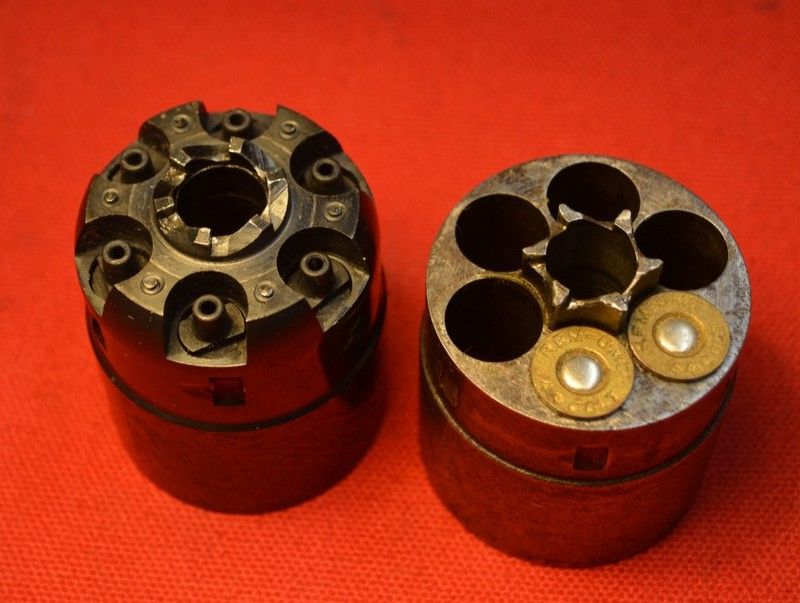 The way they did it was the Conversion cylinder is not as long as the percussion cylinder. So the tips of the old teeth could be faced off and new teeth machined, in the new positions. 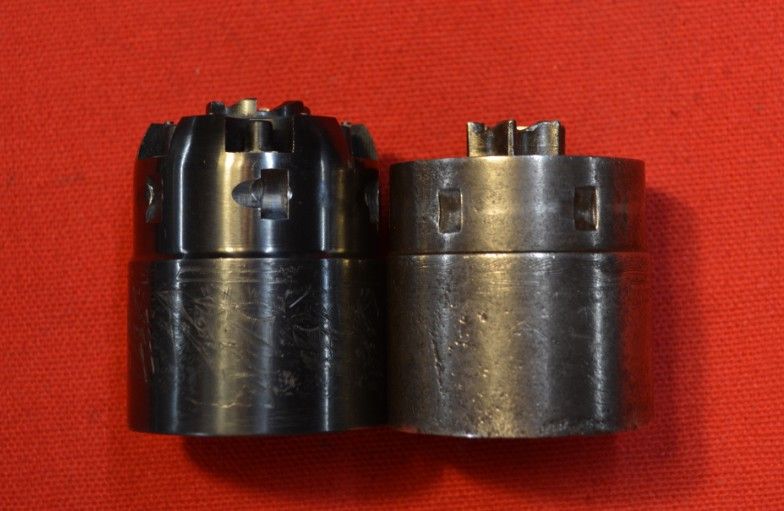 In addition, the hands were modified. The patent called for the old one finger hand of the original 1860 Colts to have an extension added that pivoted inward as the ratchet teeth rotated. The modified hand would push the teeth around the appropriate amount. Apparently this was never actually done. Instead, a two finger hand, not too different than the hand of the SAA, was fabricated to push the cylinder around the correct amount. You can see the hand next to the hammer in this photo. 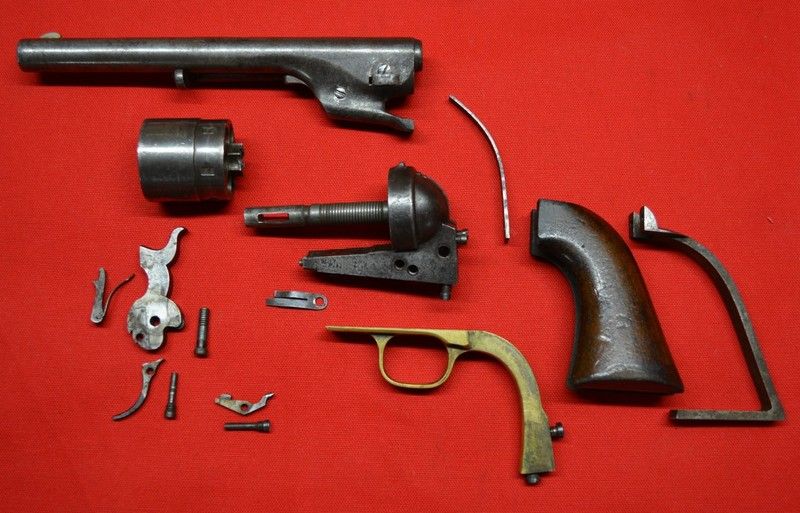
|
|
|
|
|
#18 |
|
Staff
Join Date: November 2, 1998
Location: Colorado
Posts: 21,832
|
Was there some sort of spring tension to keep that loading gate closed?
__________________
Vigilantibus et non dormientibus jura subveniunt. Molon Labe! |
|
|
|
|
#19 | |
|
Senior Member
Join Date: January 3, 2014
Location: Land of the Pilgrims
Posts: 2,033
|
Quote:
There were two different styles. The early Richards Conversions had a small detent milled into the breech plate. There was a spring plunger inside the gate that engaged the detent when the gate rotated to the open position. This was known as the internal gate spring. 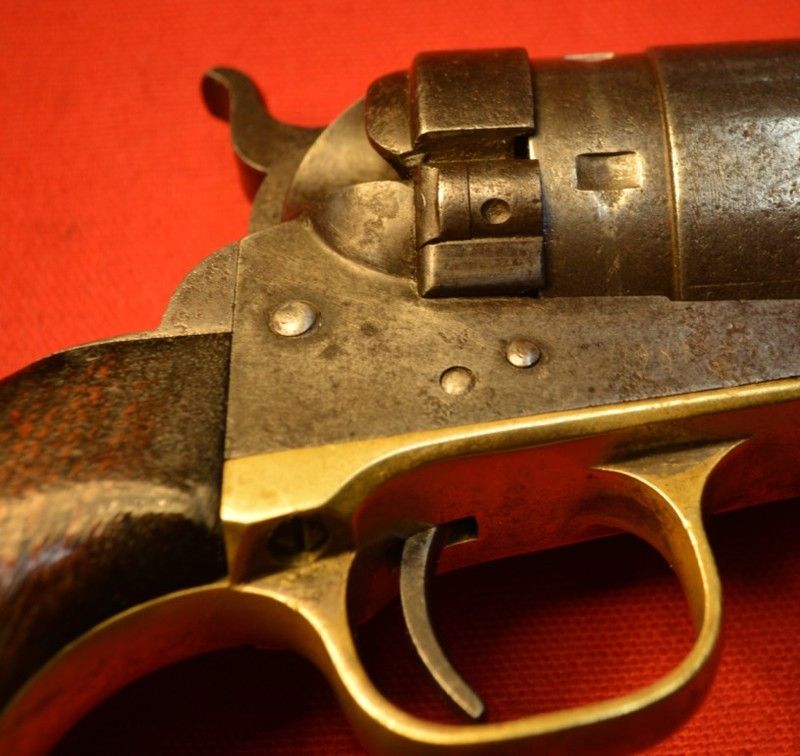 Later, a steel leaf spring was screwed to the breech plate in about the same position as the detent. The spring reached across and engaged a detent or notch in the loading gate. This was known as the external gate spring. |
|
|
|
|
|
#20 |
|
Member
Join Date: July 12, 2009
Posts: 54
|
Well explained Driftwood. I always wondered how they used the original cylinder. I know
they made new ones for some of the conversions but never had an explanation of how to use the old one. Thanks |
|
|
|
|
#21 |
|
Senior Member
Join Date: March 20, 2011
Posts: 566
|
As always, another wonderful illustrated dissertation from Driftwood Johnson, this time on the early Colt conversions. Thanks Driftwood, I learned a lot here.
I have an American Frontier Firearms Richards 1851 Navy .38 conversion made by Dave Anderson in the 1990s, but there is one thing wrong with it, it has no ejector and retains the cap and ball loading lever similar to the "Man with No Name" versions. |
|
|
|
|
#22 |
|
Member
Join Date: December 1, 2010
Posts: 23
|
The link to this thread is now saved in the "Firearms Identification Sites" folder of my favorites. Thanks!
Hold on to your wallets everyone, it looks like Photobucket has found a new way of tapping into them by charging you to post your own photos on third party sites! Last edited by EphraimKibbey; July 1, 2017 at 01:59 PM. |
|
|
|
|
#23 |
|
Senior Member
Join Date: August 17, 2008
Location: Fort Riley, Kansas
Posts: 139
|
Thanks so much for all the help guys, I really appreciate it!
|
|
|
|
|
#24 |
|
Junior Member
Join Date: June 7, 2018
Posts: 2
|
I am wanting to obtain one of the Cimarron Richards-Mason conversions in .44 Colt, but was told they have discontinuued the 8" version, and now offer only the 5-1/2" barrel. I'm kind of a stickler for originality, so does anyone know if Colt offered a 5-1/2" version?
|
|
|
 |
|
|